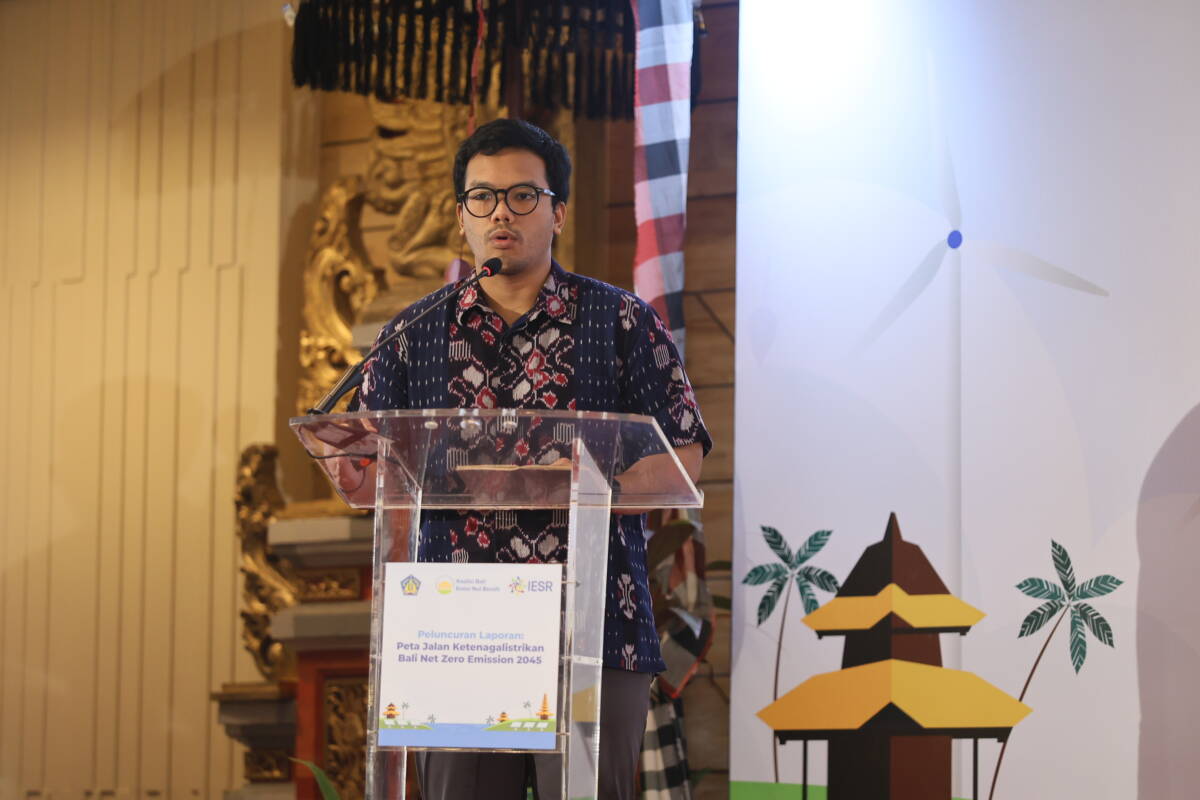Denpasar, July 15, 2025 – With reference to the values of Nangun Sat Kerthi Loka Bali, Bali Province strives to encourage energy independence and reduce emissions and pollution of air, land and water. To make this happen, on August 4, 2023, the Bali Provincial Government, supported by the Institute for Essential Services Reform (IESR), declared to move towards a net-zero emission (NZE) Bali by 2045. This initiative also collaborates with the Bali Net Zero Emission Coalition, which consists of a number of civil society organizations and philanthropic institutions.
As one of the strategies to achieve Bali NZE 2045, in 2023, IESR and the Bali Provincial Government published the Nusa Penida 100% Renewable Energy Roadmap by 2030. IESR is also designing a 100% renewable energy electricity system transformation across the entire island of Bali as expressed in the Bali Net Zero Emissions 2045 Roadmap for the Electricity Sector launched on Tuesday, July 15, 2025 in Sanur, Bali. IESR’s analysis shows that Bali’s electricity needs in 2045 and beyond can be fully sourced from renewable energy.
Wayan Koster, Governor of Bali, represented by Ida Bagus Setiawan, Head of the Manpower Office (Disnaker) and Energy and Mineral Resources (ESDM) at the launch of the Bali Roadmap for Net Zero Emissions 2045 in the Electricity Sector revealed, currently Bali is supported by a total of around 1,500 MW power plants that produce around 1,400 MW of power. With the increasing economic activity including tourism, the highest peak load reaches 1,200 MW. Bali’s electricity demand growth is also high at 7-8%, making Bali very vulnerable to a power crisis due to reserves of less than 30% and in the event of plant repairs or operational constraints.
“As an archipelago province with dependence on external energy supplies, Bali faces high energy security risks. Energy independence becomes very important, not only for the resilience and reliability of the electricity system, which supports strategic sectors, such as tourism, and the creative economy. The Bali Electricity Roadmap NZE 2045 has an important role as a strategic step in designing Bali’s energy transition efforts in a directed and measurable manner,” he said.
The Governor of Bali also hopes that this roadmap can be an important reference in encouraging the utilization or implementation of clean energy and new renewable energy and accelerating energy independence in Bali by using clean energy.
Fabby Tumiwa, Chief Executive Officer (CEO) of IESR, stated that Bali has a great opportunity to become the first province in Indonesia to be 100% supplied by renewable energy, 15 years earlier than the national target. 2060 nationally. With commitment, the right policy direction, and consistency, significant change can happen in the next five years.
“A reliable and low-carbon electricity system will add value to Bali. Besides being known as a major destination for local and foreign tourism, Bali’s energy transition will also inspire many islands in Indonesia to transform their electricity systems. For this reason, we encourage all citizens and stakeholders at the provincial and district levels to make clean energy a key basis for green development planning in Bali Province. Governor Koster’s idea of “Bali Mandiri Energi” through rooftop solar power plants needs to be supported and implemented,” Fabby said.
Fabby also encouraged PLN as the electricity provider to support Bali’s vision of 100% renewable energy by aligning the RUPTL with this vision, accelerating the development of renewable energy plants, accelerating the modernization of the electricity grid and the implementation of smart grids, integrating energy storage technology, and conducting partnerships with green energy developers. He also asked for support from the central government, Ministry of Energy and Mineral Resources, Ministry of Home Affairs, Ministry of Finance and Bappenas and Danantara to provide support through policy frameworks and incentives, as well as renewable energy funding.
The IESR study highlighted the current condition of Bali’s power system, which is supported by power plants with a total capacity of 1,461 MW. Around 76 percent of this is still dominated by fossil energy, with gas plants as the largest contributor at 688 MW, followed by coal plants at 380 MW.
Based on IESR’s analysis, Bali has 22.04 GW of renewable energy potential, with the three highest technical potentials coming from solar (21 GW), wind (515 MW), and geothermal (127 MW). If this potential is optimally utilized, Bali will be able to meet its electricity demand, which is projected to reach 44.71 TWh by 2045 with 100% renewable energy.
Alvin Putra Sisdwinugraha, Electricity and Renewable Energy Analyst, IESR explained the four stages of the period in achieving Bali 100% renewable energy by 2045.
In the 2025-2029 period, the implementation of 1.5 GW of renewable energy consisting of solar, biomass, mini hydro, waste, and wind energy has the potential to reduce emissions by 2.8 million tons of carbon dioxide equivalent. Investment needs in this period reached USD 5.8 billion.
In the 2030-2034 period, an additional 1.4 GW of renewable energy capacity and 400 MWh of energy storage is required, with an estimated investment of around USD 1.7 billion.
Furthermore, in 2035-2039, the addition of 1.24 GW of capacity requires an investment of USD 1.76-4.76 billion and has the potential to reduce emissions by 9 million tons of carbon dioxide equivalent.
Finally, in the 2040-2045 period, an additional 17 GW of renewable energy capacity and 54 GWh of energy storage is needed, with an estimated investment of USD 35 billion.
In order to realize these stages, IESR recommends five main intervention strategies. First, formalize the roadmap through regional policy instruments and regional planning documents, regional energy planning and electricity planning. Second, improving and optimizing renewable energy procurement mechanisms, and encouraging the construction of rooftop solar power plants on a large scale, Third, increasing local capacity in the field of renewable energy through skills training centers and research facilities. Fourth, drafting regulatory frameworks and derivative regulations for the development and testing of new technologies. Fifth, increasing active community participation by encouraging renewable energy utilization initiatives at the village and community levels.

